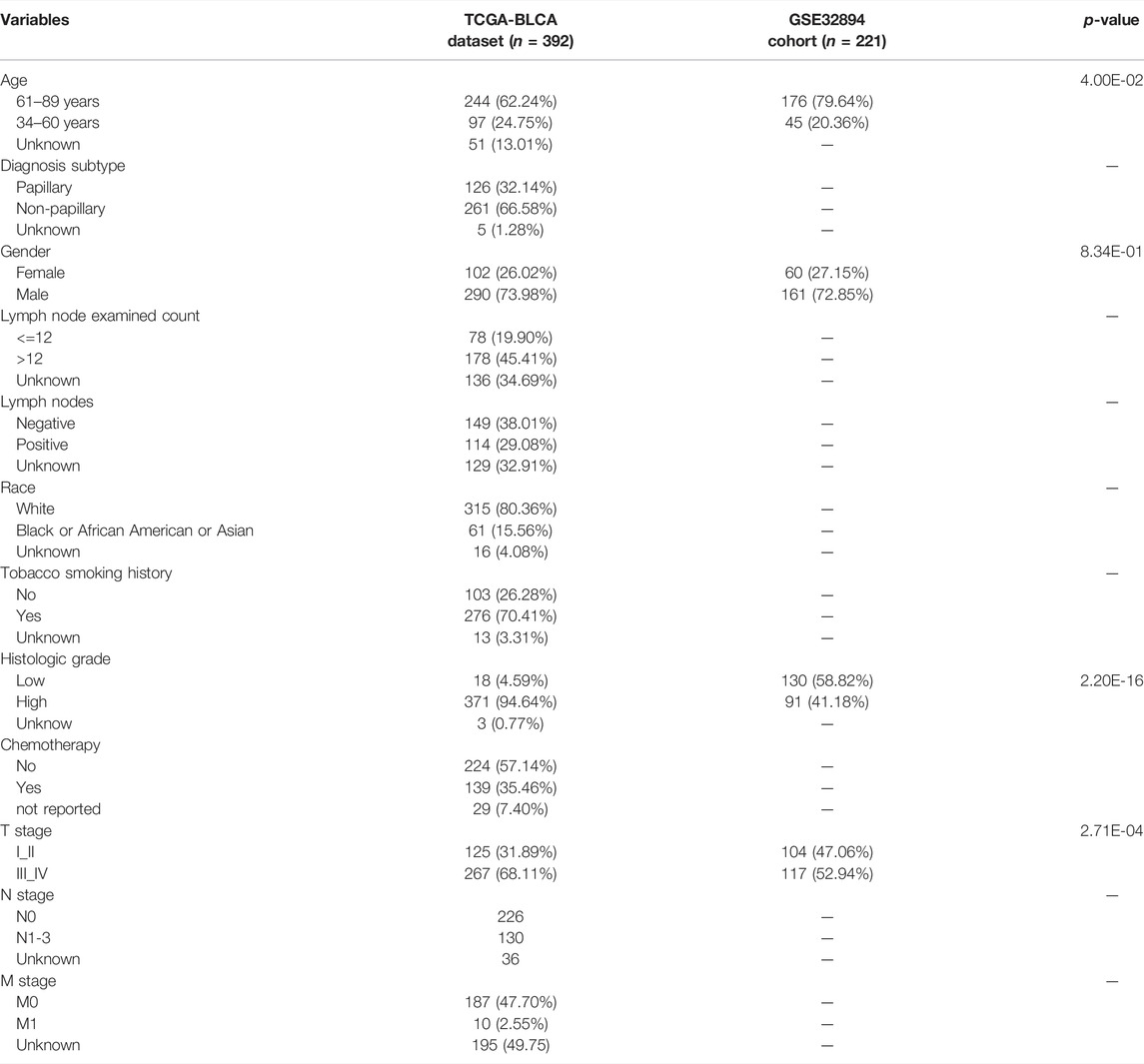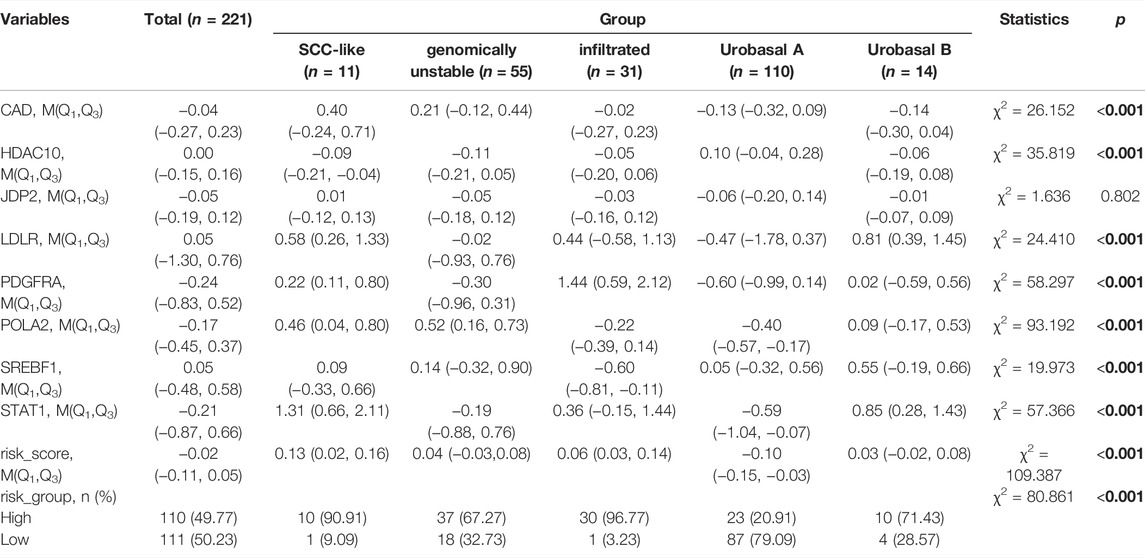- 1Department of Otolaryngology Head and Neck Surgery, Jiangxi Provincial People’s Hospital Affiliated to Nanchang University, Nanchang, China
- 2Department of Otolaryngology Head and Neck Surgery, Jiangxi Provincial People’s Hospital Affiliated to Nanchang Medical College, Nanchang, China
- 3Otorhinolaryngology Head and Neck Surgery Institute, Department of Otorhinolaryngology-Head and Neck Surgery, The First Affiliated Hospital of Nanchang University, Nanchang, China
- 4Department of General Surgery, The First Affiliated Hospital of Nanchang University, Nanchang, China
- 5The National Engineering Research Center for Bioengineering Drugs and the Technologies, The Institute of Translational Medicine, Nanchang University, Nanchang, China
Bladder cancer (BCa) is the tenth most common tumor in humans. DNA damage repair genes (DDRGs) play important roles in many malignant tumors; thus, their functions in BCa should also be explored. We performed a comprehensive analysis of the expression profiles of DDRGs in 410 BCa tumors and 19 normal tissues from The Cancer Genome Atlas database. We identified 123 DDRGs differentially expressed between BCa tumors and normal tissues, including 95 upregulated and 28 downregulated genes. We detected 22 DDRGs associated with overall survival (OS) of patients with BCa by performing univariate Cox regression analysis. To explore the interactions between OS-associated DDRGs, we constructed a PPI network, which showed that the top six DDRGs (CDCA2, FOXM1, PBK, RRM2, ORC1, and HDAC4) with the highest scores in the PPI network might play significant roles in OS of BCa. Moreover, to investigate the latent regulatory mechanism of these OS-associated DDRGs, we analyzed the transcription factors (TFs)-DDRGs regulatory network. The core seven TFs (NCAPG, DNMT1, LMNB1, BRCA1, E2H2, CENPA, and E2F7) were shown to be critical regulators of the OS-related DDRGs. The 22 DDRGs were incorporated into a stepwise multivariable Cox analysis. Then, we built the index of risk score based on the expression of 8 DDRGs (CAD, HDAC10, JDP2, LDLR, PDGFRA, POLA2, SREBF1, and STAT1). The p-value < 0.0001 in the Kaplan–Meier survival plot and an area under the ROC curve (AUC) of 0.771 in TCGA-BLCA training dataset suggested the high specificity and sensitivity of the prognostic index. Furthermore, we validated the risk score in the internal TCGA-BLCA and an independent GSE32894 dataset, with AUC of 0.743 and 0.827, respectively. More importantly, the multivariate Cox regression and stratification analysis demonstrated that the predictor was independent of various clinical parameters, including age, tumor stage, grade, and number of positive tumor lymph nodes. In summary, a panel of 8 DNA damage repair genes associated with overall survival in bladder cancer may be a useful prognostic tool.
Introduction
Cancer is a major global public health problem. Bladder cancer (BCa) is the second most frequent neoplasm of the male urinary tract and is an important cause of death [1]. BCa is now the tenth most common cancer worldwide, with over 573,278 new patients and 212,536 related deaths in 2020 [2]. According to the invasion depth, BCa are divided into non muscle-invasive bladder cancer (NMIBC, Tis, Ta, and T1) and muscle-invasive bladder cancer (MIBC, T2, T3, and T4). BCa is characterized by high morbidity, mortality, and high treatment costs, especially for MIBC [3, 4]. In recent years, although the diagnosis and treatment of BCa have rapidly improved, management of patients remains an important hurdle [5]. BCa is currently classified based on the tumor, lymph node, and metastasis classification system (TNM) for risk stratification and management. However, prediction of the therapeutic effects and outcomes based on the existing treatment strategies remains to be explored [6, 7]. DDRGs are few reported in BCa, and the risk score for molecular subtype of BCa is rarely studied. Thus, it is necessary to find new biomarkers for predicting the outcomes in patients with BCa, which may be useful for improving the management of these patients.
Human cells are challenged with various stresses, including exogenous and endogenous stresses, all of which may result in DNA damage [8, 9]. DNA misrepair can cause mutations that alter the functions of oncogenes and tumor suppressor genes, thus promoting tumorigenesis and tumor development [10]. DDRGs play critical roles in maintaining the genomic stability of human cells. In accordance with biochemical and mechanistic criteria, DDRGs can be grouped into seven capital functional pathways [11].
In this study, we have performed identification and functional analysis of differentially expressed DDRGs, and the selection of those genes that are associated with survival, and the proposal and validation of a prognostic score derived from such genes.
Materials and Methods
Clinical Cases and Data Acquisition
First, we downloaded transcriptome RNA sequencing data, including 410 BCa and 19 normal tissue samples and 412 clinical data from The Cancer Genome Atlas (TCGA) database (https://tcga-data.nci.nih.gov/tcga/). The independent validation cohort (referred to as GSE32894) with 308 BCa samples was obtained from Gene Expression Omnibus (GEO) database. We further obtained the list of DDRGs from the GeneCards database (https://pathcards.genecards.org/). BCa was standardized according to the eighth edition of the American Joint Committee on Cancer (AJCC). We subsequently collected individuals or genes based on the following criteria: individuals with survival status and survival time more than 30 days; individuals with a gene expression matrix, and the mean and median of RNA read counts greater than one. At last, there were 392 samples and 18769 RNA from TCGA and 221 patients from GEO for further analysis. The descriptive statistics of clinical features of BCa patients involved in the current study are summarized in Table 1.
Identification of Differentially Expressed DNA Damage Repair Genes
The transcriptome data were processed by using R x64 3.6.1 software (https://www.r-project.org/). The R package limma and Wilcox test were applied to obtain the differentially expressed genes. False-discovery rate (FDR) < 0.01 and log2|fold change (FC)| > 1 were set as the cutoff value. Differentially expressed DDRGs were extracted from all of the differentially expressed genes, and it was performed as described previously [12].
Gene Ontology and Kyoto Encyclopedia of Genes and Genomes Pathway Analysis
Gene ontology analysis (GO) was applied to annotate differentially expressed DDRGs. The results of GO analysis were presented in three parts, namely, biological processes (BP), molecular functions (MF), and cellular components (CC). In addition, Kyoto Encyclopedia of Genes and Genomes (KEGG) analysis was used to perform pathway enrichment analysis. Both GO analysis and KEGG analysis were conducted using R x64 3.6.1 software [12].
Gene Set Enrichment Analysis
As described previously [13], a GSEA version 4.0.1 was first downloaded from the genomic enrichment analysis website (http:/Sofare.Broadstitute.org/GSEA/index.jsp). Then, the differentially expressed genes dataset was imported into the software with reference to the molecular signature database gene set (msigdb.v7.2.symbols gmt). Each analysis was repeated 1,000 times according to the default weighted enrichment statistical method using a genomic error detection rate (FDR) of <0.25 and a pedigree error rate (family‐wise error rate) < 0.05. GSEA analysis included four main statistical data: enrichment score (ES), standardized ES (normalized ES), error detection rate, and p-value.
Construction of Protein-Protein Interaction Network and Hub Genes Selection
In this step, we constructed the PPI network of prognosis-associated differentially expressed DDRGs that had been identified in previous analysis. The Search Tool for the Retrieval of Interacting Genes (STRING) database (version 11.0; https://string-db.org/cgi/input.pl) was used to evaluate the PPI information. Cytoscape software (version 3.8.1) was used to visualize the PPI networks and select hub genes for further discussion [12]. The CBioportal database was used to analyze mutations and copy number variations (CNVs) of differentially expressed DDRGs.
Univariate and Multivariate Cox Regression Analysis
To identify survival-related genes, we integrated the expression of DDRGs with the OS of BCa patients. The relationships of DDRGs with OS were then analyzed by univariate Cox regression analysis. All samples in TCGA datasets were randomly assigned to the training dataset (60%) and the internal validation dataset (40%). These survival-related DDRGs were integrated into a stepwise multivariate Cox regression to select the optimal model for prognosis [14]. Finally, the prognostic model of BCa was established based on the multivariate co-efficiency multiplied by expression data. The formula was as follows: Risk score = coefficient(a) × gene expression(a) + coefficient(b) × gene expression(b) + ··· + coefficient(n) × gene expression(n). According to the median of risk scores, the patients were divided into high-risk and low-risk groups. The survminer package of R software was used to apply the Kaplan–Meier (KM) curve to investigate the connection between DDRGs and prognosis. The multivariate Cox analysis and stratification analysis were used to explore independent prognostic factors of BCa patients [15].
TF Analysis and TFs-DDRGs Regulatory Network
The Cistrome Cancer database (http://cistrome.org/CistromeCancer/), a comprehensive database of expression profiles and public ChIP-seq profiles from TCGA, predicts target genes and enhancer profiles of transcription factors (TFs) in TCGA cancer types [16]. Validated TFs were downloaded (318 in total, p < 0.05) with statistical relevance to the tumor. These data were combined and the differentially expressed TFs were used to draw a volcano map. Correlation tests between the TFs and prognosis-related DDRGs were performed, and the regulatory network of TFs-DDRGs was presented with Cytoscape [17].
Statistical Analysis
The data were collected, analyzed, and presented using R software (version 3.6.1) and the corresponding software packages. The performance of the prognostic index was assessed by conducting the receiver operating characteristic (ROC) curve analysis.
Results
Identification of Differentially Expressed DDRGs
We studied 410 BCa tissues and 19 normal tissues from the TCGA database. We identified 4,893 differentially expressed genes (DEGs) using the Wilcoxon signed-rank test; 3,468 of them were upregulated and 1,425 were downregulated. There were 123 differentially expressed DDRGs extracted from this set of genes, including 95 upregulated and 28 downregulated genes (Figures 1A,B).
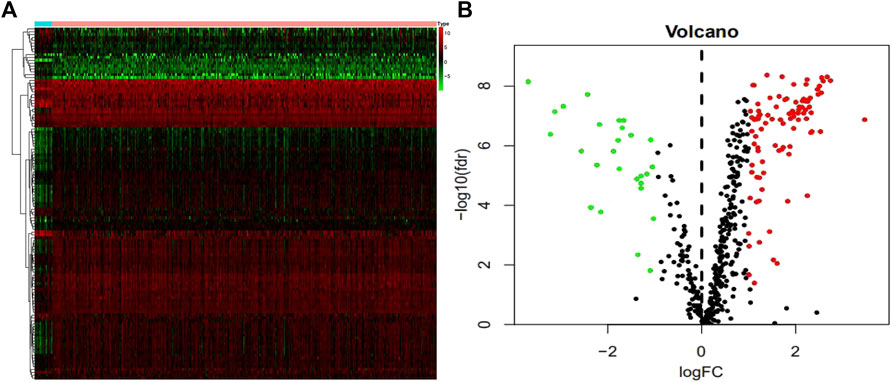
FIGURE 1. Differentially expressed DNA damage repair genes (DDRGs). Differentially expressed DDRGs are shown in the heat map (A) and volcano map (B). The red dot indicates the highly expressed genes, the green dot indicates the low expressed genes, and the black dot indicates the genes without differentially expressed genes.
According to gene ontology (GO) analysis in the biological process category, these differentially expressed DDRGs were chiefly enriched in “DNA replication,” “cell division,” and “mitotic nuclear division” (Supplementary Figure S1). GO analysis related to cellular components (CC) showed that they were mainly enriched in “nucleoplasm,” “nucleus,” and “cytoplasm” (Supplementary Figure S1B). GO analysis related to molecular functions (MF) demonstrated that they were involved in “protein binding,” “3′-5′DNA helicase activity,” and “chromatin binding” (Supplementary Figure S1C). KEGG pathway analysis revealed that “cell cycle,” “homologous recombination,” and “p53 signaling pathway” were the most enriched pathways (Supplementary Figure S1D). GSEA of the DEGs revealed that these genes were enriched in “SHEDDEN_LUNG_CANCER_POOR_SURVIVAL_A6”, “GOBERT_OLIGODENDROCYTE_DIFFERENTIATION_UP”, and “MARSON_BOUND_BY_E2F4_UNSTIMULATED” (Supplementary Figure S2).
Identification of Survival-Associated DDRGs
To explore the prognostic potential of the differentially expressed DDRGs in BCa patients, we directed our efforts toward uncovering molecular biomarkers. First, we downloaded the clinical information of patients with BCa. By univariate Cox regression analysis, the top 22 differentially expressed DDRGs that were considered relevant with OS (Table 2). Most of these genes had positive hazard ratios, which indicated a higher risk for BCa patients.
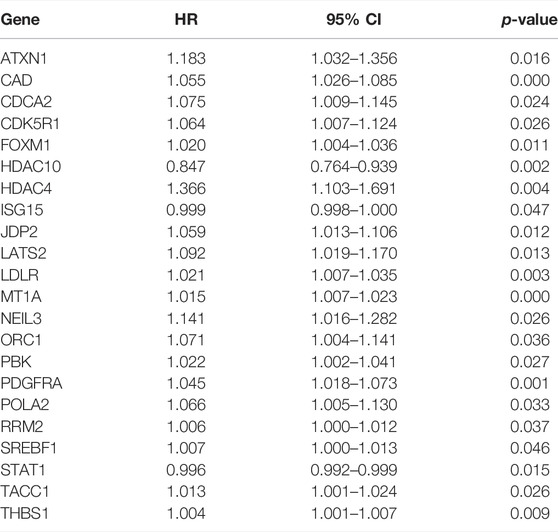
TABLE 2. The prognostic value of differentially expressed DDRGs by univariate Cox regression analysis.
Furthermore, the results of the enrichment analysis of the differentially expressed DDRGs showed that OS-related DDRGs were significantly enriched in similar GO terms and KEGG pathways, such as “negative regulation of transcription from RNA polymerase II promoter,” “G1/S transition of mitotic cell cycle,” and “positive regulation of smooth muscle cell proliferation” (Figure 2A). Also, “protein binding,” “protein kinase activity,” and “protein kinase binding” (Figure 2B) were the most significant MF. Furthermore, “nucleoplasm,” “nucleus,” and “cytoplasm” (Figure 2C) were the most significant CC. In addition, “Human papillomavirus infection,” “Pyrimidine metabolism,” and “MicroRNAs in cancer” were the most significant pathways (Figure 2D).
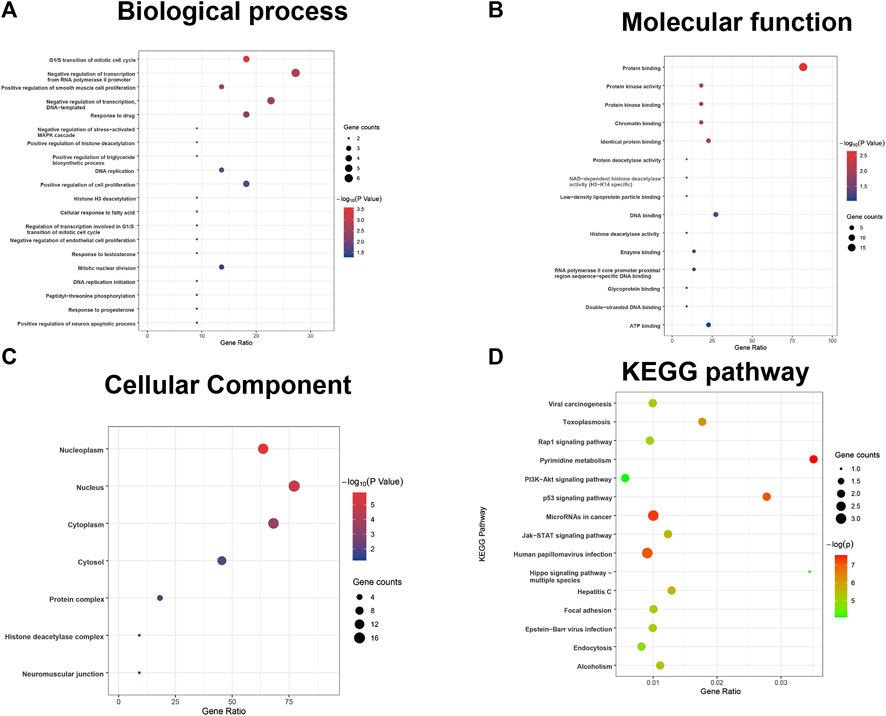
FIGURE 2. GO terms and pathways analysis of the differentially expressed overall survival (OS)-related DDRGs. (A) Gene ontology analysis: biological processes. (B) Gene ontology analysis: molecular functions. (C) Gene ontology analysis: cellular components. (D) The significant enriched KEGG pathways.
Construction of Protein–Protein Interaction Network Based on Prognostic DDRGs
PPI network analysis of OS-associated differentially expressed DDRGs was performed using STRING (version 11.0) and visualized using Cytoscape (version 3.8.1). It showed that PBK, CDCA2, FOXM1, RRM2, ORC1, and HDAC4 were the hub genes (Supplementary Figure S3). According to mutation and CNV analysis for BCa performed using the cBioportal database, the three most common types of OS-related DDRGs included amplification, missense mutations, and deep deletions (Supplementary Figure S4). We also performed the regression analysis of risk score on tumor mutational burden with the p-value of 0.96. The scatter plot was shown in Supplementary Figure S7.
Construction of Transcription Factors Regulatory Network
To investigate the possible molecular mechanisms regulating the OS-related DDRGs, we analyzed the TF-DDRG interaction. First, we observed the expression profiles of 318 TFs; there were 77 TFs that were differentially expressed between BCa tissues and non-tumor tissues. Among them, 41 were upregulated and 33 were downregulated (Figure 3A). We then constructed a regulatory network based on these 77 TFs and 22 OS-related DDRGs. We set cutoff thresholds as correlation scores >0.4 and p-values < 0.001. The TF-based regulatory network is shown in Figure 3B. We identified the key regulated factors of OS-related DDRGs using the TRRUST database. Seven key transcription factors (NCAPG, DNMT1, LMNB1, BRCA1, E2H2, CENPA, and E2F7) were found to be associated with the regulation of these DDRGs.
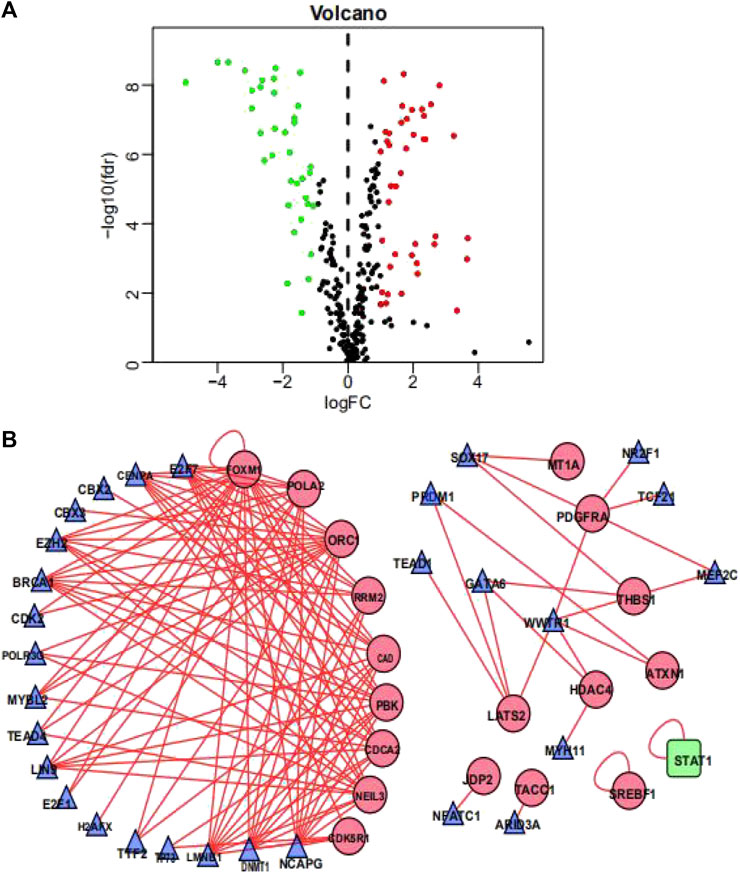
FIGURE 3. Transcription factors-mediated regulatory network. (A) Volcano plot of differentially expressed Transcription Factors (TFs)between BCa and non-tumors tissues. (B) The transcription regulatory network according to the clinically relevant DDRGs and differentially expressed TFs. The circle in a node reflects clinically relevant DDRGs and triangle represented as differentially expressed TFs. The shades of color reflect the correlation.
Development and Validation of the DNA Damage Repair Prognostic Index
We separated the TCGA-BLCA cohort into training dataset (60%) and internal validation dataset (40%) by random selection. The following optimal model was chosen by a stepwise multivariate Cox analysis: [Expression level of CAD * (0.042)] + [Expression level of HDAC10*(−0.146)] + [Expression level of JDP2 * (0.069)] + [Expression level of LDLR * (0.022) + [Expression level of PDGFRA * (0.070)] + [Expression level of POLA2 * (0.108)] + [Expression level of SREBF1 * (0.008)] + [Expression level of STAT1 *(−0.009)] (Table 3). We built a prognostic index-risk score to divide patients with BCa into two groups, the high-risk group and the low-risk group, and then we made a risk curve. The KM analysis showed that there was a statistically significant difference in OS between the two groups with p-value < 0.0001 (Figure 4A). A higher risk score was associated with a shorter survival time. The area under the ROC curve (AUC) was 0.771, p = 2.34E-07 (Figure 4A), which indicated a high forecast ability of the DDRG-based risk score in survival surveillance. The prognostic index was confirmed in TCGA-BLCA internal validation dataset, with a similar KM plot (p-value <0.0001) and ROC curve (AUC = 0.743, p = 3.77E-06) (Figure 4B). The survival status and risk scores of each BCa patient are listed in Supplementary Figure S5A for the TCGA-BLCA training dataset, Supplementary Figure S5B for the internal validation dataset, and Supplementary Figure S5C for the GSE32894 cohort.
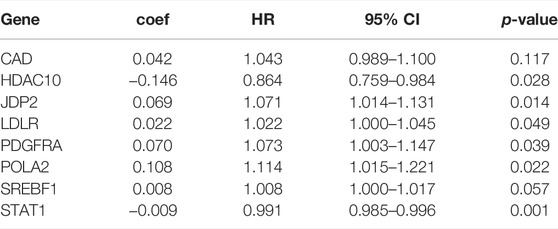
TABLE 3. Multivariate cox analysis to develop a prognostic index based on these differentially expressed DNA damage repair genes.
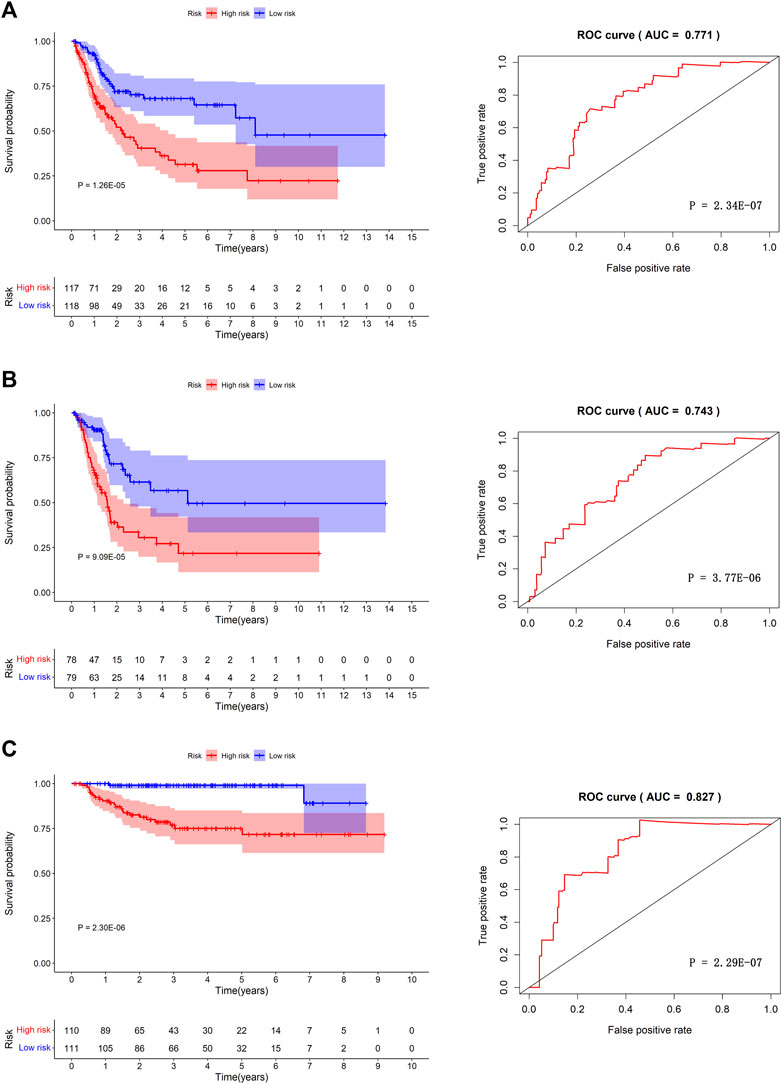
FIGURE 4. The prognosis model in TCGA-BLCA training dataset, TCGA-BLCA internal validation dataset and GSE32894 independent validation cohort. Kaplan-Meier survival curves between high-risk group and low-risk group (left) and the receiver operating characteristic (ROC) curve of the risk scores (right) in TCGA-BLCA training dataset (A), TCGA-BLCA internal validation dataset (B), and GSE32894 validation cohort (C).
Furthermore, we validated the performance of the prognostic model in an independent dataset, GSE32894, through the KM survival plot and ROC curve analysis. A significant p-value < 0.0001 in the KM survival analysis and an area under the ROC curve of 0.827 verified the efficiency of our prognostic model, p = 2.29E-07 (Figure 4C). To compare the prediction ability of risk score with clinical features, we conducted ROC analyses for each clinical feature (Supplementary Figure S6A) and combined clinical features and risk scores (Supplementary Figure S6B). The results showed that the AUC of the prognostic index was larger than those based on age, count of examined lymph nodes, positive lymph nodes, and tumor stage (Supplementary Figure S6A). When combining clinical features and risk scores, we found that our prognostic index could improve the clinical prognostication (Supplementary Figure S6B).
Correlation Between the Prognostic Index and Other Clinicopathologic Characteristics
Univariate Cox analysis revealed that age, number of lymph nodes, number of positive lymph nodes, stage, and risk scores were related to OS. After adjusting for age, gender, race, tobacco smoking history, number of lymph nodes, number of positive lymph nodes, and clinical stage by multivariate Cox analysis, the risk score was still associated with OS, with a p-value <0.001 (Table 4). However, we noticed that age, number of lymph nodes, and number of positive lymph nodes were also related to OS (p < 0.05). In addition, chemotherapy treatment is an important factor to OS. To further confirm the independence of the risk scores, we performed a stratification analysis. All of the patients were separated into two subgroups as shown in Table 1. We found that the risk scores still correlated with OS (p < 0.05, Figure 5).

TABLE 4. The Cox regression analysis of clinical characteristics and the prognostic signature in TCGA-BLCA cohort.
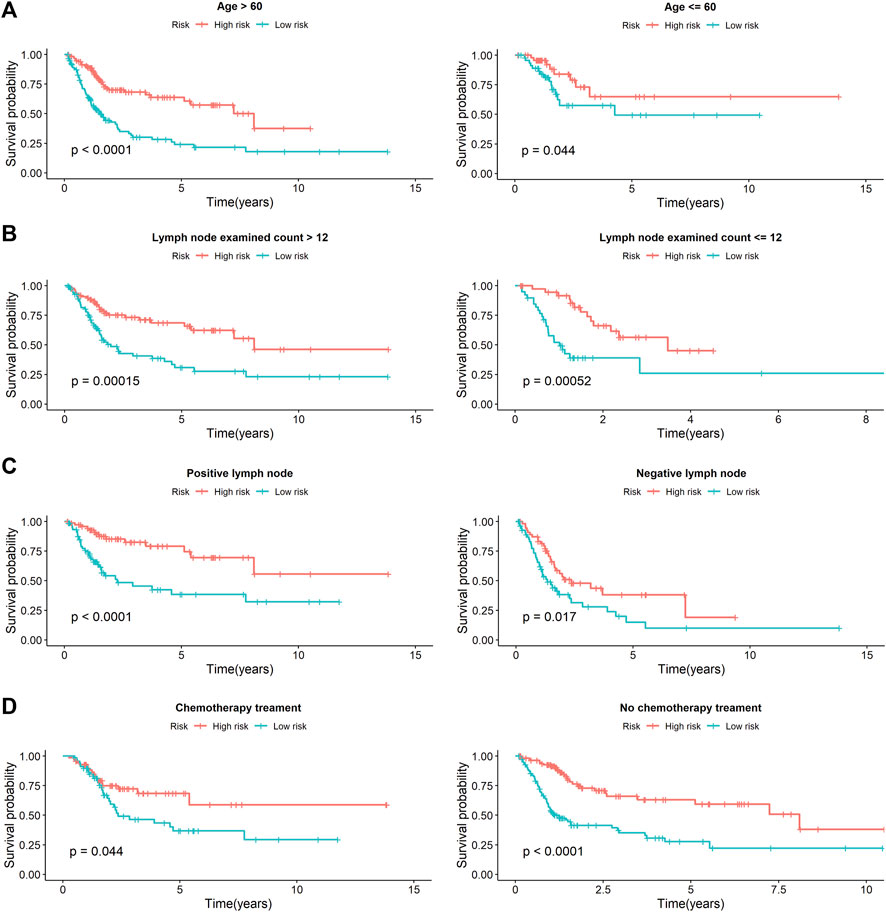
FIGURE 5. The stratification analysis of prognostic signature in BCa patients with different clinical parameters. (A) The prognostic utility of the signature in BCa patients with different age groups. (B) The prognostic utility of the signature in BCa patients with number of lymph nodes. (C) The prognostic utility of the signature in BCa patients with number of positive lymph nodes. (D) The prognostic utility of the signature in BCa patients with tumor mutational burden.
We additionally accessed the correlation between DDRG index and subtypes in TCGA and GEO database (p < 0.001, Supplementary Figure S8). Except SREBF1, other DDRGs were correlated with diagnosis subtypes between Non-Papillary and Papillary (Table 5). Except JDP2, the expression of each gene was related to the molecular subtypes (Table 6).

TABLE 5. Difference analysis of gene expression between non papillary and papillary in the TCGA database.
Discussion
Deficiency in DDR pathways is an early and critical step in tumorigenesis and plays an important role in tumor progression and response to platinum-based systemic therapy [18, 19]. With the development of genome sequencing, some novel molecular biomarkers have been screened out to predict the prognosis and offer personalized treatment guidance for reference.
In the present study, we performed a comprehensive integrated analysis of DDRGs and interpreted their clinical traits in patients with BCa. With the improvement of medical treatment and genome-sequencing techniques, a better understanding of human tumor occurrence and progression has been achieved [20]. Instead of conventional clinical-pathological subtypes, molecular subtypes of cancers have gained increasing attention in the prognosis of patients [21]. Molecular subtypes of BCa might have an important role in predicting prognosis and guiding clinical therapy [22–24].
Up to now, there have been a number of predicting models or indexes for BCa patients. Alessandra Allione et al. [25] suggested that DNA damage levels measured in peripheral blood mononuclear cells of patients with BCa may potentially represent a prognostic marker associated with poor survival. Duan et al. [26] developed a panel for diagnosis based on three lncRNAs in serum, which was confirmed to perform better than urine cytology. Fang et al. [27] found that miR-205 may be a promising biomarker for the detection and prognosis evaluation of BCa. MierXiati A et al. [28] prospectively built and validated a 12-gene signature for the survival of non-muscle invasive bladder cancer (NMIBC) and found that the prognostic power of this score was superior to that of clinical data. Ingelmo-Torres et al. [29] constructed a predicting model based on two urinary cell microRNAs, miR-140-5p and miR-92a-3p. Chen et al. [30] identified a four-gene signature that was useful in overall survival prediction in patients with urinary bladder cancer. The selected four genes might become potential therapeutic targets and diagnostic markers for urinary bladder cancer.
However, few studies have focused on the DNA damage repair of BCa, and there have been no robust prognostic models based on DDR. In this study, we established a model of DDRGs to predict the prognosis of BCa patients and explored the underlying mechanism.
In our study, univariate Cox regression analysis showed that 22 DDRGs were significantly associated with OS, indicating that those genes could be very important prognostic factors for patients with BCa. The functions of OS-related DDRGs are listed in Supplementary Table S1.
To explore the possible molecular mechanisms, we used a TF-mediated network to identify the TFs that might mediate these DDRGs. The TF-DDRG regulatory network might be helpful to guide future mechanistic studies. We found seven core TFs, namely, NCAPG, DNMT1, LMNB1, BRCA1, E2H2, CENPA, and E2F7, to be critical regulators of the OS-related DDRGs. The functions of the seven TFs are listed in Supplementary Table S2.
In this study, through multivariate Cox regression analysis, we first identified a set of 8 DDRGs (CAD, HDAC10, JDP2, LDLR, PDGFRA, POLA2, SREBF1, and STAT1) that were significantly associated with OS of BCa patients. We also developed a new prognostic index. The overall survival of patients with low risk was significantly higher compared with that in patients with high risk. The AUC of ROC was 0.743 in TCGA-BLCA internal validation dataset, suggesting the potential of this prognostic index. Furthermore, we performed an independent validation to validate our prognostic signature in the GSE32894 cohort. The results demonstrated the robustness of our model, with p-value <0.0001 in the survival plot and an area under the ROC curve of 0.827. Both TCGA validation and GEO validation suggested the predictive power of this index. Due to the characteristical difference between TCGA dataset only including MIBC patients and GEO cohort including NMIBC and MIBC samples, we removed the NMIBC patients and re-validated the prognostic signature in GSE32894 cohort. The KM plot represented that the high and low DDRG index group would not significantly estimate the OS with p-value of 0.15 (data not shown), which may be caused by the heterogeneity and complexity of the transcriptome profile of MIBC patients in the two datasets.
Multivariate Cox analysis and stratification analysis demonstrated that the risk score was an independent predictor for bladder cancer by controlling the potential confound clinical factors. Notably, DDRG index was proved to be associated with poor survival OS both in the chemotherapy and non-chemotherapy subgroups. After clinical correction, we constructed prognostic markers, which may be useful to be independent predictors; they also showed high clinical practicability to predict the development of BCa. The confirmation of a BCa prognosis index based on DDRGs provides evidence for appropriate clinical therapy, which is not only useful for assessment of patient terms, but it is also helpful for further understanding the functions of DDRGs. Nevertheless, this requires further research.
In our study, according to diagnosis subtype, we have divided BCa into non-Papillary and Papillary groups. Unfortunately, the diagnosed subtype was not strongly related to BCa’ survival time. Compared to previously proposed molecular subtyping, DDRG risk score that we have proposed may be more convincing. Because the AUC of DDRG risk score is 0.827, which is higher than previous study (the AUC is 0.761) [30]. Meanwhile, this study has few limitations. First, we obtained all of the data of this study from a public database, and the number of samples in the public database was limited. Second, transcriptomic analysis can only reflect certain aspects of the DNA damage status, not global alterations. Third, this was a retrospective study, and a multicenter and prospective study is needed to validate our results by in vitro and in vivo experiments.
Conclusion
In this study, we have performed identification and functional analysis of differentially expressed DDRGs, and the selection of those genes that are associated with survival, and the proposal and validation of a prognostic score derived from such genes. In summary, a panel of 8 DNA damage repair genes associated with overall survival in bladder cancer may be a useful prognostic tool.
Data Availability Statement
The datasets presented in this study can be found in online repositories. The names of the repository/repositories and accession number(s) can be found in the article/Supplementary Material.
Author Contributions
Conception and design: YY, JX, and DD. Collection and assembly of data: YY and YX. Data analysis and interpretation: YY, JX, DD, and FZ. Manuscript writing: YY, JY, and FZ. Paper revision: YY, FZ, and JY. Final approval of manuscript: YY, JY, YX, JX, DD, and FZ.
Funding
This study was supported by The First Affiliated Hospital of Nanchang University (YFYPY202002), and The Key Research and Development Plan of Science and Technology Department of Jiangxi Province ((20203BBGL73201; 20192BBGL70025) and the Natural Science Foundation of JiangXi Province (20212BAB216077).
Conflict of Interest
The authors declare that the research was conducted in the absence of any commercial or financial relationships that could be construed as a potential conflict of interest.
Acknowledgments
We appreciate the contributors to public databases, including TCGA, GEO, GeneCards, STRING, DAVID, Cistrome Cancer, and kobas3. We thank LetPub (www.letpub.com) for providing linguistic assistance during the preparation of this manuscript.
Supplementary Material
The Supplementary Material for this article can be found online at: https://www.por-journal.com/articles/10.3389/pore.2022.1610267/full#supplementary-material
Supplementary Figure S1 | Gene function enrichment and pathway analysis of the differentially expressed DNA damage repair genes (DDRGs). (A) Gene ontology analysis: biological processes. (B) Gene ontology analysis: molecular functions. (C) Gene ontology analysis: cellular components. (D) The significant enriched KEGG pathways.
Supplementary Figure S2 | Gene set enrichment analysis (GSEA) of the differentially expressed OS-related DNA damage repair genes (DDRGs). Only listed the top 8 significantly enriched pathways ES, enrichment score; FDR, false discovery rate; GSEA, gene set enrichment analysis.
Supplementary Figure S3 | Protein interaction network of overall survival (OS)-related DNA damage repair genes. (A) Protein–protein interaction network constructed through STRING database based on prognostic DNA damage repair genes (DDRGs). (B) Protein–protein interaction network of prognostic DNA damage repair genes built based on connectivity using Cytoscape.
Supplementary Figure S4 | Mutation landscape of OS-related differentially expressed DDRGs.
Supplementary Figure S5 | The distribution of risk scores based on DDRGs in TCGA-BLCA dataset and GSE32894 cohort. (A) The distribution of patients’ risk scores (top) and survival time (bottom) in high risk and low risk groups based on TCGA-BLCA training dataset. (B) The distribution of patients’ risk scores (top) and survival time (bottom) in high risk and low risk groups based on TCGA-BLCA internal validation dataset. (C) The distribution of patients’ risk scores (top) and survival time (bottom) in high risk and low risk groups based on GSE32894 dataset.
Supplementary Figure S6 | The comparison of ROC curve analysis for different clinical features and prognotic index.
Supplementary Figure S7 | The linear regression of risk score on tumor mutational burden.
Supplementary Figure S8 | The boxplot of risk scores in different subtypes. (A) The boxplot of risk scores in diagnosis subtypes based on the TCGA-BLCA dataset. (B) The boxplot of risk scores in the molecular subtypes based on the GSE32894 cohort.
References
1. Siegel, RL, Miller, KD, and Jemal, A Cancer Statistics, 2019. CA Cancer J Clin (2019) 69(1):7–34. doi:10.3322/caac.21551
2. Sung, H, Ferlay, J, Siegel, RL, Laversanne, M, Soerjomataram, I, Jemal, A, et al. Global Cancer Statistics 2020: GLOBOCAN Estimates of Incidence and Mortality Worldwide for 36 Cancers in 185 Countries. CA Cancer J Clin (2021) 71(3):209–49. doi:10.3322/caac.21660
3. Kamat, AM, Hahn, NM, Efstathiou, JA, Lerner, SP, Malmström, P-U, Choi, W, et al. Bladder Cancer. Lancet (2016) 388(10061):2796–810. doi:10.1016/s0140-6736(16)30512-8
4. Antoni, S, Ferlay, J, Soerjomataram, I, Znaor, A, Jemal, A, and Bray, F Bladder Cancer Incidence and Mortality: A Global Overview and Recent Trends. Eur Urol (2017) 71(1):96–108. doi:10.1016/j.eururo.2016.06.010
5. Baumann, BC, Guzzo, TJ, He, J, Keefe, SM, Tucker, K, Bekelman, JE, et al. A Novel Risk Stratification to Predict Local-Regional Failures in Urothelial Carcinoma of the Bladder after Radical Cystectomy. Int J Radiat Oncol Biol Phys (2012) 85(1):81–8. doi:10.1016/j.ijrobp.2012.03.007
6. Paner, GP, Stadler, WM, Hansel, DE, Montironi, R, Lin, DW, and Amin, MB Updates in the Eighth Edition of the Tumor-Node-Metastasis Staging Classification for Urologic Cancers. Eur Urol (2018) 73(4):560–9. doi:10.1016/j.eururo.2017.12.018
7. Gallan, AJ, Choy, B, and Paner, GP Contemporary Grading and Staging of Urothelial Neoplasms of the Urinary Bladder. Surg Pathol Clin (2018) 11(4):775–95. doi:10.1016/j.path.2018.07.006
8. López-Otín, C, Blasco, MA, Partridge, L, Serrano, M, and Kroemer, G The Hallmarks of Aging. Cell (2013) 153(6):1194–217. doi:10.1016/j.cell.2013.05.039
9. Lieber, MR The Mechanism of Double-Strand DNA Break Repair by the Nonhomologous DNA End-Joining Pathway. Annu Rev Biochem (2010) 79:181–211. doi:10.1146/annurev.biochem.052308.093131
10. Shimizu, I, Yoshida, Y, Suda, M, and Minamino, T DNA Damage Response and Metabolic Disease. Cel Metab (2014) 20(6):967–77. doi:10.1016/j.cmet.2014.10.008
11. Wang, G, Guo, S, Zhang, W, Li, Z, Xu, J, Li, D, et al. A Comprehensive Analysis of Alterations in DNA Damage Repair Pathways Reveals a Potential Way to Enhance the Radio-Sensitivity of Esophageal Squamous Cell Cancer. Front Oncol (2020) 10:575711. doi:10.3389/fonc.2020.575711
12. Xu, N, Ke, Z-B, Lin, X-D, Chen, Y-H, Wu, Y-P, Chen, Y, et al. Development and Validation of a Molecular Prognostic index of Bladder Cancer Based on Immunogenomic Landscape Analysis. Cancer Cel Int (2020) 20:302. doi:10.1186/s12935-020-01343-3
13. Xiao, H, Wang, B, Xiong, HX, Guan, JF, Wang, J, Tan, T, et al. A Novel Prognostic index of Hepatocellular Carcinoma Based on Immunogenomic Landscape Analysis. J Cel Physiol (2020) 236:2572–91. doi:10.1002/jcp.30015
14. Wang, L, Shi, J, Huang, Y, Liu, S, Zhang, J, Ding, H, et al. A Six-Gene Prognostic Model Predicts Overall Survival in Bladder Cancer Patients. Cancer Cel Int (2019) 19:229. doi:10.1186/s12935-019-0950-7
15. Heagerty, PJ, Lumley, T, and Pepe, MS Time-dependent ROC Curves for Censored Survival Data and a Diagnostic Marker. Biometrics (2000) 56(2):337–44. doi:10.1111/j.0006-341x.2000.00337.x
16. Mei, S, Meyer, CA, Zheng, R, Qin, Q, Wu, Q, Jiang, P, et al. Cistrome Cancer: A Web Resource for Integrative Gene Regulation Modeling in Cancer. Cancer Res (2017) 77(21):e19–e22. doi:10.1158/0008-5472.CAN-17-0327
17. Bader, GD, and Hogue, CW An Automated Method for Finding Molecular Complexes in Large Protein Interaction Networks. BMC Bioinform (2003) 4:2. doi:10.1186/1471-2105-4-2
18. Yin, M, Grivas, P, Wang, Q-E, Mortazavi, A, Emamekhoo, H, Holder, SL, et al. Prognostic Value of DNA Damage Response Genomic Alterations in Relapsed/Advanced Urothelial Cancer. Oncologist (2020) 25(8):680–8. doi:10.1634/theoncologist.2019-0851
19. Curia, MC, Catalano, T, and Aceto, GM MUTYH: Not Just Polyposis. World J Clin Oncol (2020) 11(7):428–49. doi:10.5306/wjco.v11.i7.428
20. Lappalainen, T, Scott, AJ, Brandt, M, and Hall, IM Genomic Analysis in the Age of Human Genome Sequencing. Cell (2019) 177(1):70–84. doi:10.1016/j.cell.2019.02.032
21. Zhao, L, Lee, VHF, Ng, MK, Yan, H, and Bijlsma, MF Molecular Subtyping of Cancer: Current Status and Moving toward Clinical Applications. Brief Bioinform (2019) 20(2):572–84. doi:10.1093/bib/bby026
22. Lerner, SP, McConkey, DJ, Hoadley, KA, Chan, KS, Kim, WY, Radvanyi, F, et al. Bladder Cancer Molecular Taxonomy: Summary from a Consensus Meeting. Bladder Cancer (2016) 2(1):37–47. doi:10.3233/BLC-150037
23. Sanli, O, Dobruch, J, Knowles, MA, Burger, M, Alemozaffar, M, Nielsen, ME, et al. Bladder Cancer. Nat Rev Dis Primers (2017) 3:17022. doi:10.1038/nrdp.2017.22
24. Aine, M, Eriksson, P, Liedberg, F, Höglund, M, and Sjödahl, G On Molecular Classification of Bladder Cancer: Out of One, Many. Eur Urol (2015) 68(6):921–3. doi:10.1016/j.eururo.2015.07.021
25. Allione, A, Pardini, B, Viberti, C, Oderda, M, Allasia, M, Gontero, P, et al. The Prognostic Value of Basal DNA Damage Level in Peripheral Blood Lymphocytes of Patients Affected by Bladder Cancer. Urol Oncol Semin Original Invest (2018) 36(5):241.e15–241.e23. doi:10.1016/j.urolonc.2018.01.006
26. Duan, W, Du, L, Jiang, X, Wang, R, Yan, S, Xie, Y, et al. Identification of a Serum Circulating lncRNA Panel for the Diagnosis and Recurrence Prediction of Bladder Cancer. Oncotarget (2016) 7(748):78850–8. doi:10.18632/oncotarget.12880
27. Fang, Z, Dai, W, Wang, X, Chen, W, Shen, C, Ye, G, et al. Circulating miR-205: A Promising Biomarker for the Detection and Prognosis Evaluation of Bladder Cancer. Tumor Biol (2016) 37(6):8075–82. doi:10.1007/s13277-015-4698-y
28. Abudurexiti, M, Xie, H, Jia, Z, Zhu, Y, Zhu, Y, Shi, G, et al. Development and External Validation of a Novel 12-Gene Signature for Prediction of Overall Survival in Muscle-Invasive Bladder Cancer. Front Oncol (2019) 9(9):856. doi:10.3389/fonc.2019.00856
29. Ingelmo-Torres, M, Lozano, JJ, Izquierdo, L, Carrion, A, Costa, M, Gómez, L, et al. Urinary Cell microRNA-Based Prognostic Classifier for Non-muscle Invasive Bladder Cancer. Oncotarget (2017) 8(11):18238–47. doi:10.18632/oncotarget.15315
Keywords: biomarkers, prognosis, bladder cancer, differentially expressed genes, DNA damage repair genes
Citation: Yang Y, Yu J, Xiong Y, Xiao J, Dai D and Zhang F (2022) Prognostic Analysis of Differentially Expressed DNA Damage Repair Genes in Bladder Cancer. Pathol. Oncol. Res. 28:1610267. doi: 10.3389/pore.2022.1610267
Received: 16 December 2021; Accepted: 21 April 2022;
Published: 24 May 2022.
Edited by:
Anna Sebestyén, Semmelweis University, HungaryCopyright © 2022 Yang, Yu, Xiong, Xiao, Dai and Zhang. This is an open-access article distributed under the terms of the Creative Commons Attribution License (CC BY). The use, distribution or reproduction in other forums is permitted, provided the original author(s) and the copyright owner(s) are credited and that the original publication in this journal is cited, in accordance with accepted academic practice. No use, distribution or reproduction is permitted which does not comply with these terms.
*Correspondence: Daofeng Dai, ZGFvZmVuZ2RhaUBuY3UuZWR1LmNu; Feng Zhang, ZmVuZ3poYW5nMDcwOUBob3RtYWlsLmNvbQ==
†These authors have contributed equally to this work
 Yong Yang
Yong Yang Jieqing Yu3†
Jieqing Yu3† Yuanping Xiong
Yuanping Xiong Daofeng Dai
Daofeng Dai Feng Zhang
Feng Zhang